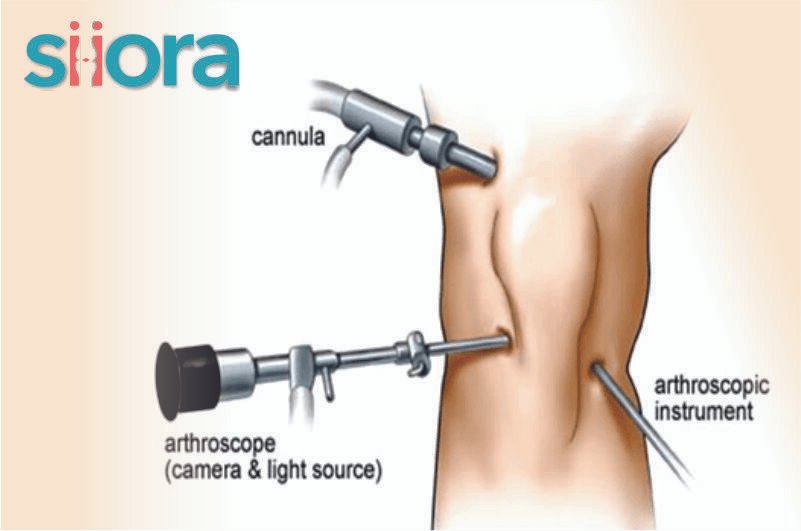The field of orthopedics is attaining new heights year after year, and the introduction to arthroscopy is one of the best examples. Newer and better orthopedic implants & instruments are coming into the market and surgeons are trying new surgical techniques. Collectively, the orthopedic sector is skyrocketing. In this blog post, we will see arthroscopy surgery in detail. Let us start with a brief introduction.
What is Arthroscopy?
Arthroscopy is a form of minimally invasive surgery that orthopedic surgeons use to diagnose and treat different types of joint problems. In other words, we can say that the arthroscopy technique is devised for the precise diagnosis of joint ailments that imaging studies like x-rays cannot.
Orthopedic surgeons perform the arthroscopic procedure using special tools and instruments. Orthopedic specialists often opt for arthroscopy when conventional diagnostic procedures are not able to detect the cause of joint pain and other symptoms. This surgery is done as an outpatient procedure.

What is the Procedure for Arthroscopy?
Arthroscopy is a surgical technique, and an experienced orthopedic professional performs it. Here are the steps of arthroscopic surgery:
At first, it is important to know that the procedure is carried out under anesthesia. This is to ensure no discomfort and pain during the procedure.
The surgeon will use special surgical instruments to make an incision around the joint with the injury. Here, the incision is very small or the size of a buttonhole.
An arthroscope, a small wire having a tiny camera and a light source at the end is inserted through the incision. This camera will help generate images of the inside of the joint (muscles, tendons, & ligaments), and they will be visible live on a big television screen. The surgeon will move the arthroscope in the joint to see what’s causing pain and other symptoms.
If the procedure is being done for the treatment of a condition, another hole of the same size is made. Through that hole, the orthopedic surgeon will insert appropriate tools and implants. They are arthroscopy implants. Different types of arthroscopy implants are available depending on the type of joint.
After the correction of the joint ailment, the orthopedic surgeon will remove the instrument and close the incisions before transferring the patient to the recovery room.
This is how orthopedic surgeons perform the most arthroscopic surgeries. However, surgeons may suggest different techniques in certain cases.
Why Would You Need Arthroscopy?
An orthopedic specialist may perform an arthroscopy to diagnose joint problems that show nothing or are unclear on imaging tests. When it comes to the use of arthroscopy for the treatment, then the surgeon will opt for the same when non-surgical methods do not respond.
The technique can relieve painful symptoms of many joint problems that involve damage to cartilage surfaces and other soft tissues in/around the joint. Some of the common arthroscopic surgeries that surgeons perform include:
- Removal of the meniscus (partial meniscectomy), meniscus repair, or meniscus transplantation
- Anterior Cruciate Ligament (ACL) reconstruction or Posterior Cruciate Ligament (PCL) reconstruction
- Removing inflamed synovial tissue
- Reconstruction of damaged articular cartilage
- Removing loose bone fragments or cartilage
- Treatment of patellar problems
- Treatment of sepsis (infection) in the joint
- Treatment of hip joint conditions like femoroacetabular impingement (FAI), labral tears, osteochondritis dissecans, or sciatic nerve compression (piriformis syndrome)
- Treatment of shoulder joint problems like rotator cuff tears, acromioclavicular osteoarthritis, or frozen shoulder
- Treatment of symptoms of repetitive strain surgery
- Treatment of spinal deformity, disc herniation, or tumors
These are some of the common conditions that arthroscopy may treat and besides this, there are many others.
How to Prepare for Arthroscopy Surgery?
Preparations for arthroscopy depend on the joint and the type of injury being treated. However, the orthopedic specialist will guide you on how to prepare for the surgery depending on its type. General preparations that you can make before arthroscopy will include:
Tell About the Medicines You Are Taking
When you come to know about arthroscopy, it is important to tell your orthopedic specialist about any medicines or supplements you are taking. This is because some pills may hinder the procedure or cause severe complications, and hence, the doctor will ask you to stop them before surgery.
Confirm Whether You Have any Medical Health Conditions
Besides medicines, it is also important to tell your doctor about health ailments other than the current joint problem, if you have any. This will alert the surgeon to take precautions, if required, during the procedure.
8-Hour Fasting
In most surgical procedures, the surgeons advise going empty stomach, and for that, 8-hour fasting is important. However, if the need for any special care or medicine is there, the orthopedic specialist will guide you beforehand.
Wear Loose Clothes
Before going for arthroscopy, the patient will need to change and wear a hospital gown. So, while going to the hospital, you need to wear loose and comfortable clothes so that you can change quickly. Besides this, make sure not to wear any gadgets or jewelry for arthroscopy as they will be removed.
Go with an Attendant
Well, any of your family members or friends should accompany you. This is because there must be someone to take you back home as you cannot drive on your own.
Are There Any Risks with Arthroscopy?
Arthroscopy is surgery and just like others, it also carries some risks. However, the occurrence of risks is low. Here are common risks that people may face after arthroscopy:
Nerve Damage
There are certain procedures like meniscus suturing during which the risk of nerve damage is there. This may also occur when the surgical tools are manipulated to examine/treat the joint ailment. However, experienced orthopedic surgeons perform arthroscopy, and the chances of the risk are very low.
Infection
Whether will a tiny incision or a bigger one, when the first line of defense against infection in our body i.e., skin, is opened, the risk of infection is there. So, arthroscopy also carries the risk of infection but again, it is low. Apart from this, an infection may also occur if the patient fails to take proper care of the surgical wound.
Blood Clots
The risk of blood clots after arthroscopy is high in patients with blood disorders or genetic conditions that make the patient prone to blood clots. Besides them, the risk is low. However, after most arthroscopic surgeries, the orthopedic specialist may suggest blood thinners or anticoagulant drugs to prevent clotting. Besides this, certain exercises also play a vital role in preventing the formation of clots.
Pain, Swelling, & Inflammation
In very few cases, the patients may experience persistent pain, swelling, stiffness, or inflammation around the joint after arthroscopy. If other treatments fail to improve these issues, the orthopedic specialist may suggest repeat surgery.
What Recovery is Like After this Surgery?
The best thing about arthroscopy is that recovery doesn’t take much longer but, it is important to follow post-surgical instructions. After the surgery, the orthopedic surgeon will prescribe certain medications to improve pain & inflammation. He will also suggest certain exercises for better results. RICE therapy helps the most. It includes rest, ice, compression, and elevation. This therapy not only helps alleviate pain but also improves swelling and blood flow in the joint. Hence, helps with quick and better recovery.
Above all, the orthopedic specialist will also apply temporary splints to protect the joint. if arthroscopy is done in the knee joint, crutches or slings may be suggested to move around easily.
With all this, physical therapy helps regain the strength and flexibility of the joint. This must be performed under the guidance of a specialist.
What Are the Advantages of the procedure?
Arthroscopy offers many advantages over conventional surgeries. Here are some of the noticeable benefits of arthroscopy:
Accurate Diagnosis
Though arthroscopy is not a common diagnostic procedure, it is for the diagnosis of various joint ailments. The procedure is advantageous to use as it can help detect tiny tears in the ligaments, muscles, and cartilage. However, an x-ray examination is a standard procedure for the diagnosis of fractures, and it can also show large tears in soft tissues. But when it comes to tiny tissue breaks in the joints, X-rays may fail to detect them.
Arthroscopy uses a special camera that can look into the layers of tissues and produce clear images on the HD screen. Hence, it helps with diagnostic accuracy.
Quick Procedure
Arthroscopy is not a long surgery and takes only around an hour in most cases. Hence, the patient need not stay in OT for long.
Smaller Incisions
As you know buttonhole size incisions are made during arthroscopy which is much smaller than ORIF. As a result, low blood loss is there and less risk of the formation of blood clots after surgery.
Low Risk of Infection
When a surgeon opens the skin during surgery, the risk of infection is always there. The larger the incision, the greater will be the risk of infection. This doesn’t mean smaller incisions don’t carry infection risk but it is low. Thus, the chances of infection during arthroscopy are less.
Shorter Recovery Period
During arthroscopy, the incision is small, and less tissue damage is there. Hence, the recovery occurs much faster than it is after ORIF surgery. As a result, the patient can return to normal routine activities in less time.
Less Reliance on Pain Medications
The intensity of post-surgical pain in arthroscopy is less and hence, the patient need not take many analgesics.
Minimal Scarring
Nobody wants scars and when it comes to arthroscopy, it does not leave big ones. Now, if we talk about surgical scars on joints, especially after ORIF, the skin on the scar is thicker and heavier. Hence, if they are bigger in size, they may restrict the range of motion. With arthroscopy, patients need not face such problems.
Siora Surgicals Pvt. Ltd. is a renowned manufacturer of a wide range of arthroscopy implants and other CE-certified trauma devices. Operating for over 3 decades, the company uses medical-grade stainless steel and titanium to manufacture implants. It has served clients in over 40 countries and is currently supplying orthopedic products to around 130 national and international distributors and orthopedic surgeons. Siora is also an experienced OEM/contract manufacturing service provider.







